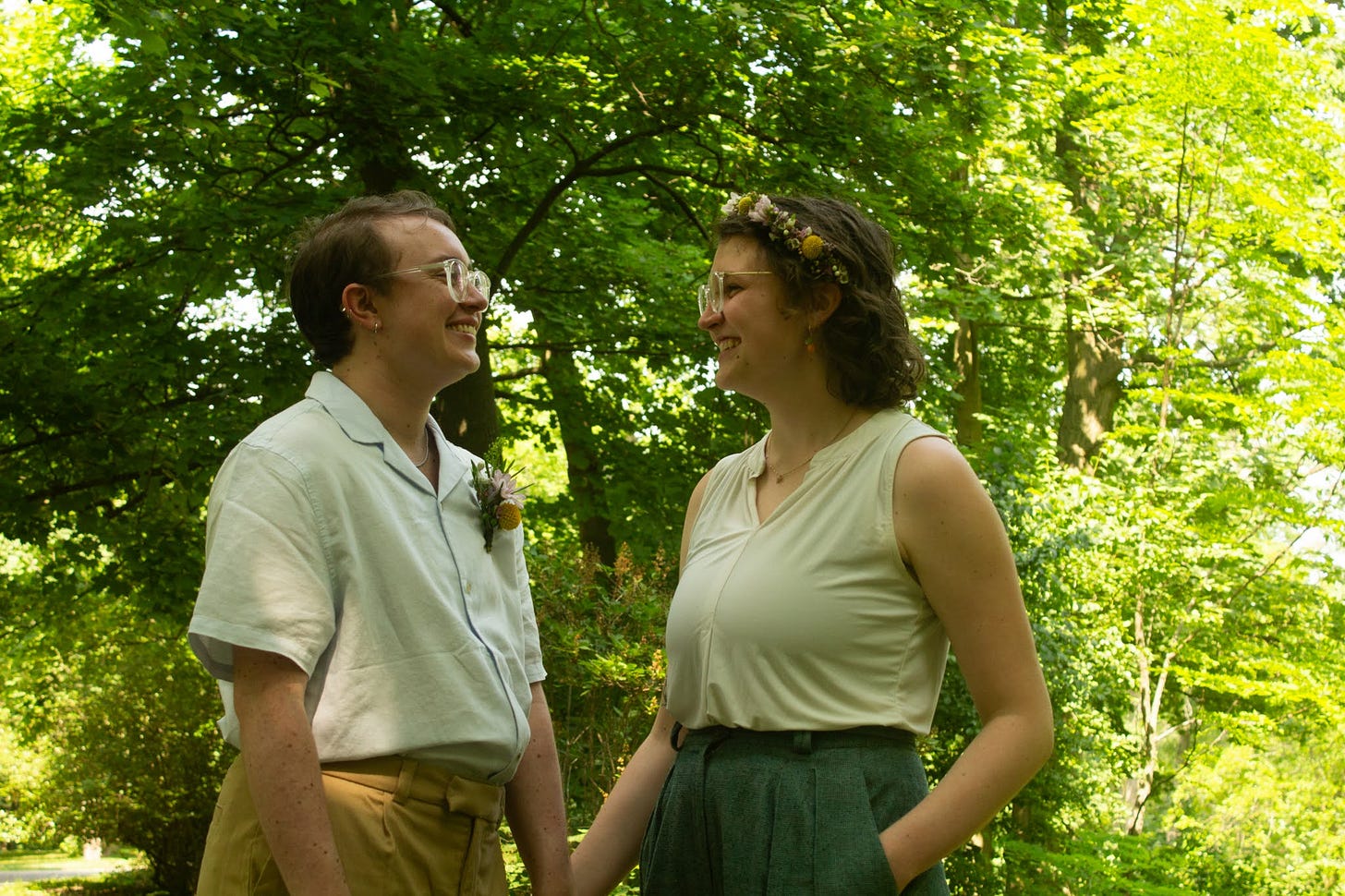Welcome to Postcards from the Porch! I’m so happy to have you here. Pour yourself a cup of coffee and stay awhile on my virtual balcony.
June was a momentous month for me. My birthday is halfway through the month. Zoe and I got married the week after that in a small ceremony at a public park, officiated by one of our closest friends and witnessed by members of our families. And, at the end of the month, I had the first anniversary of my gender-affirming hormone therapy (GAHT). So many celebrations!

When I started GAHT (also called hormone replacement therapy, or HRT—the terms are used interchangeably; you can read more about the terminology here), I was living with my parents and younger sister in San Antonio. I came out to them as a trans man three weeks before I started testosterone, a timeline that felt rushed to them.
Before I came out, I had identified as nonbinary for over a year. But if you were to ask any of my friends from college, they’d tell you another—truer—story. They’d tell you about my poems pining for a sea glass-smooth chest, my giddy trips to the barber shop, my late night declarations: “I think I might be a man, and I don’t want to talk about it right now.” To them, coming out as a trans man was more a formality than anything else.
For my family, it was much more serious. I had spent years thinking about my gender-queerness; they didn’t have the privilege of time. I learned to balance doing what was best for me and my body with ensuring some level of comfort for my family. It took patience and many long conversations.
Some of my familial relationships are stronger for having shared my transition with them and holding space for their complicated feelings in response. Some are weaker than ever; I often wonder if they can be mended. For a long time, I felt the burden of mending was in my hands, and some days, I feel the urge to pick up the needle and thread. It has been difficult—but necessary—to accept that I have done my best and done enough. No relationship is the responsibility of a single person.
Another relationship that changed for the better was with one of the newest members of my family: Zoe. For years, we knew that we would be partners in life, whatever form that took. It confused a lot of people; we knew we would share a home and, someday, a child before we knew that we would kiss each other, let alone kiss each other in front of our families after exchanging rings.
Ours is a love story in reverse; all the practicalities came first. The romance was waiting for things to fall into place. One of those things was my gender identity.
Before I could find comfort in the tenderness, affection, and physicality of our relationship, I had to find comfort in my body. That was—and is—an uphill battle, to be sure. I’m still not where I’d like to be with my self-perception and self-talk (that’s what therapy is for, friends).
Even so, GAHT gave me the greatest gift I will ever receive: my body became my own again. I self-administered my shots when I did subcutaneous injections. When I switched to intramuscular injections, the ritual became one shared with Zoe—I prepped the T, and they eased the needle into my muscle. (We later learned that easing is the wrong approach—a precise jab is far less painful.) For years, my body was an object seized from me: by puberty, by depression, by sexual violence. Now, as I pinch the redistributed fat on my rounded belly or wipe the sweat from my thinly mustached upper lip in the summer heat, I do so with the knowledge that these changes were my choice.
For the first time in my life, when someone compliments my appearance, I actually believe them. I am handsome. I made myself handsome. I made myself.
A year in, and things are changing again. I have a dog—Marmalade is a little shit, and I love her, my big stinky baby. I survived the odyssey that is a legal name change—so much paperwork. I have an appointment to meet with a new doctor for gender-affirming care; my injections have been too painful to be manageable anymore, so I have to explore other options for administering my T. I am a newlywed!
Life changes in so many beautiful and unexpected ways, and some painful ways, too. I can’t wait to see what the next season has in store.
You’re not hired. Like every queer person in the United States, I’m thinking about the Supreme Court’s ruling in 303 Creative LLC v. Elenis. There’s nothing I can say that hasn’t already been said better by someone else (when it comes to the courts, I often find it helpful to see what Chase Strangio is saying). I can say with certainty that there aren’t any queer people looking at Lorie Smith’s portfolio and thinking, Wow, she would be perfect for my wedding website! Not. A. Chance. The ruling feels like a joke; it serves as yet another reminder that our liberation cannot be found in the courts. And if you actually needed that reminder, you should probably reflect on why you haven’t accepted that reality sooner.
They’re orcanizing! This is my inner child’s dream come true. I’ve always loved killer whales, so any news of their revenge against humanity is welcome in my household and my heart. You can read my killer whale-inspired personal essay here. I could go on about orcas for… a while, but I won’t. Instead, enjoy this meme that says it all:

Do octopuses dream of aquatic sheep? If there’s one animal I love more than killer whales, it’s octopuses, so I was thrilled when Zoe shared this story with me. I’m not a scientist, but I’ll do my best to summarize. We used to think that only humans experienced two sleep stages—slow wave sleep and rapid eye movements (REMs). Then, we learned more and extended that to all vertebrates. Now? Researchers think that extends to invertebrates, too. Or at least one invertebrate: the octopus. The Reiter lab found that octopuses experience neural activity while asleep that’s similar to what they experience while awake, the same way we experience REM sleep. So, instead of just having one sleep stage, it looks like they have two. Humans and octopuses would have evolved to have two-stage sleep separately, and it seems to be a quality suggestive of complex cognition (octopuses have big brains and are known for being clever, so I think that’s fair to say). Are they dreaming?
Not necessarily. But the skin patterning and coloration observed during their sleep stage with neural activity are similar to patterns that present during particular experiences in the octopus’s waking hours, so it’s possible that they’re dreaming, and their skin patterning is changing to respond to the content of their dreams the same way it would respond to the content of their lives. Isn’t that incredible? To think there might be a creature out there who wears its dreams on its skin. If you want to hear the story straight from the source, you can read the article here.
It’s the time of year to celebrate my brother’s birthday. C, you’re one of my favorite people on the planet. Congrats on another spin around the sun.
My partner publishes a newsletter each week, and I might be biased, but I think it’s pretty damn good. I highly recommend subscribing to Swamp Prospect so you can hear from Zoe.
Speaking of them, Zoe and I became members of our city’s art museum. Supporting the arts and unlimited museum visits? Sign us up! I encourage you to find something in your community to support that will bring you joy.
I recently read Qwo-Li Driskill’s poetry collection Walking with Ghosts. It was incredibly moving, and I can’t recommend it enough. S/he is a two-spirit, mixed-race, queer poet and professor, and hir writing is beautiful and heartbreaking.
That’s all for now. Thank you for taking the time to join me on the porch!








